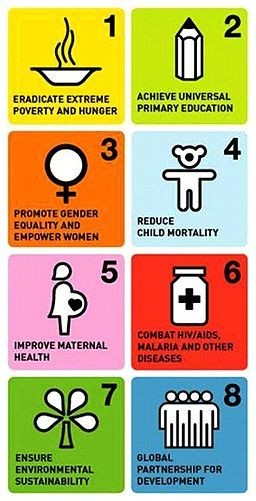How Successful Has the World Been in Meeting the Millennium Development Goals?
Fifteen years ago, the United Nations (UN) gathered the world’s leaders together to discuss moving toward building a global partnership for the 21st century that would, in particular, address extreme poverty, as well as 7 other topics such health and education. These became known as the Millennium Development Goals (MDGs). These leaders set bold targets of accomplishing 8 goals objectives by 2015.
- Goal 1: Eradicate extreme poverty and hunger
- Goal 2: Achieve universal primary education
- Goal 3: Promote gender equality and empower women
- Goal 4: Reduce child mortality
- Goal 5: Improve maternal health
- Goal 6: Combat HIV/AIDS, malaria and other diseases
- Goal 7: Ensure environmental sustainability
- Goal 8: Develop a global partnership for development
If one were to ask, how successful the world has been in meeting the MDGs? The responses would be mixed; success for some, less so in others. The good news is that the level of country donations funding the costs of the MDGs objectives has risen from US$81 billion in 2000 to US$134 billion by 2014. The UN encourages countries to pledge 0.7% of their gross national income to help fund overseas development. The bad news, only a handful of European nations (currently 5 of 28 nations of the Development Assistance Committee) have met this level of the funding commitment. The UN recently released a gap assessment report that evaluates how well the responses to the 8 goals. While evaluating all 8 goals is beyond this one blog, for now we will review the first goal and its 3 components, eradicating extreme poverty and hunger. Extreme poverty and hunger are defined by the World Bank as those that live on less than US$1.25 per day. In 1990, roughly 1.91 billion persons were living on less than $1.25 a day, and today this number has decreased >50% to 836 million.
- A: Between 1990 and 2015, ½ the proportion of people whose income is less than $1.25/day.
- B: Achieve full, decent, and productive employment for all, no matter their gender or age.
- C: Between 1990 and 2015, ½ the proportion of people suffering from hunger.
The number of food insecure individuals is an issue of contentious debate, the UN indicates that over 800 million people face extreme poverty and malnourishment. Even so, the UN claims that the first of the MDGs were met five years ahead of the 2015 target. To accomplish this, a 1990 baseline is used to achieve the goal of halving extreme poverty by 2015. Has Goal 1 been achieved? Could our efforts lead to the demise of extreme hunger and poverty?
Again it is hard to say, gauging something as challenging as an accurate count of those facing extreme poverty is problematic. It might be fair to conclude that regardless of whatever level presently exists, it is still too high. More can be done to reduce these figures. Part of this includes allowing new crop production technologies to be widely adopted by those most in need.
So, where does the problem lie? It is widely acknowledged that we produce enough food to feed everyone on the planet, but it is not reaching those that live in poverty for reasons such as war and climate. War and climate won’t be changing in the short term, so we must assume that the distribution of the existing food will continue to be a challenge. A big part of the solution is to put new technologies in the hands of small landholder farmers. Giving these farmers the choice of what technologies to adopt, better regulations are required, greater levels of communication and outreach from technology developers and acceptance by those critical of new technologies that small landholder farmers have the right to decide for themselves.



![By Rahulkepapa (Own work) [CC BY-SA 3.0 (http://creativecommons.org/licenses/by-sa/3.0)], via Wikimedia Commons](https://i2.wp.com/upload.wikimedia.org/wikipedia/commons/thumb/c/c2/MDGs.jpg/256px-MDGs.jpg?resize=256%2C501&ssl=1)